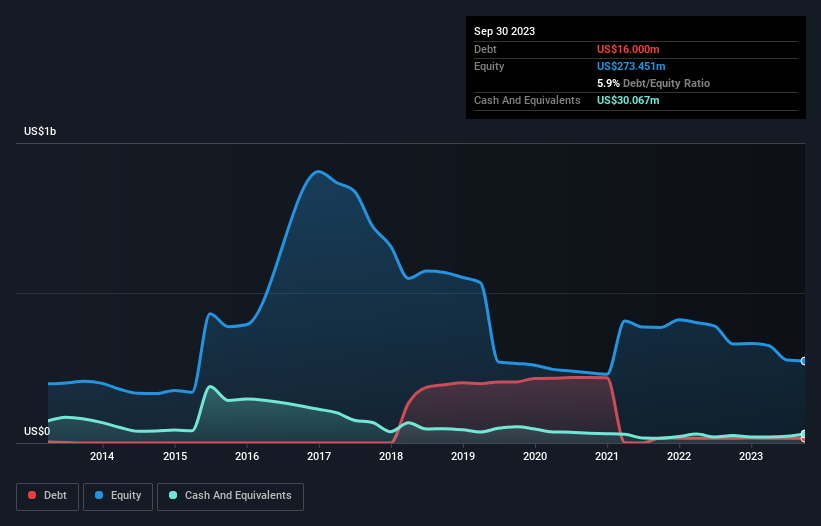- United States
- /
- Media
- /
- NasdaqGS:SCOR
These 4 Measures Indicate That comScore (NASDAQ:SCOR) Is Using Debt Extensively
Howard Marks put it nicely when he said that, rather than worrying about share price volatility, 'The possibility of permanent loss is the risk I worry about... and every practical investor I know worries about.' When we think about how risky a company is, we always like to look at its use of debt, since debt overload can lead to ruin. As with many other companies comScore, Inc. (NASDAQ:SCOR) makes use of debt. But the real question is whether this debt is making the company risky.
When Is Debt A Problem?
Debt is a tool to help businesses grow, but if a business is incapable of paying off its lenders, then it exists at their mercy. Ultimately, if the company can't fulfill its legal obligations to repay debt, shareholders could walk away with nothing. However, a more common (but still painful) scenario is that it has to raise new equity capital at a low price, thus permanently diluting shareholders. Of course, the upside of debt is that it often represents cheap capital, especially when it replaces dilution in a company with the ability to reinvest at high rates of return. When we examine debt levels, we first consider both cash and debt levels, together.
See our latest analysis for comScore
How Much Debt Does comScore Carry?
As you can see below, comScore had US$16.0m of debt, at September 2023, which is about the same as the year before. You can click the chart for greater detail. However, its balance sheet shows it holds US$30.1m in cash, so it actually has US$14.1m net cash.

How Strong Is comScore's Balance Sheet?
We can see from the most recent balance sheet that comScore had liabilities of US$178.9m falling due within a year, and liabilities of US$66.5m due beyond that. Offsetting this, it had US$30.1m in cash and US$46.5m in receivables that were due within 12 months. So its liabilities outweigh the sum of its cash and (near-term) receivables by US$168.9m.
This deficit casts a shadow over the US$92.3m company, like a colossus towering over mere mortals. So we'd watch its balance sheet closely, without a doubt. At the end of the day, comScore would probably need a major re-capitalization if its creditors were to demand repayment. comScore boasts net cash, so it's fair to say it does not have a heavy debt load, even if it does have very significant liabilities, in total.
Notably, comScore made a loss at the EBIT level, last year, but improved that to positive EBIT of US$5.9m in the last twelve months. There's no doubt that we learn most about debt from the balance sheet. But ultimately the future profitability of the business will decide if comScore can strengthen its balance sheet over time. So if you want to see what the professionals think, you might find this free report on analyst profit forecasts to be interesting.
Finally, a company can only pay off debt with cold hard cash, not accounting profits. comScore may have net cash on the balance sheet, but it is still interesting to look at how well the business converts its earnings before interest and tax (EBIT) to free cash flow, because that will influence both its need for, and its capacity to manage debt. Happily for any shareholders, comScore actually produced more free cash flow than EBIT over the last year. There's nothing better than incoming cash when it comes to staying in your lenders' good graces.
Summing Up
Although comScore's balance sheet isn't particularly strong, due to the total liabilities, it is clearly positive to see that it has net cash of US$14.1m. The cherry on top was that in converted 106% of that EBIT to free cash flow, bringing in US$6.2m. So while comScore does not have a great balance sheet, it's certainly not too bad. The balance sheet is clearly the area to focus on when you are analysing debt. However, not all investment risk resides within the balance sheet - far from it. Case in point: We've spotted 3 warning signs for comScore you should be aware of.
At the end of the day, it's often better to focus on companies that are free from net debt. You can access our special list of such companies (all with a track record of profit growth). It's free.
Valuation is complex, but we're here to simplify it.
Discover if comScore might be undervalued or overvalued with our detailed analysis, featuring fair value estimates, potential risks, dividends, insider trades, and its financial condition.
Access Free AnalysisHave feedback on this article? Concerned about the content? Get in touch with us directly. Alternatively, email editorial-team (at) simplywallst.com.
This article by Simply Wall St is general in nature. We provide commentary based on historical data and analyst forecasts only using an unbiased methodology and our articles are not intended to be financial advice. It does not constitute a recommendation to buy or sell any stock, and does not take account of your objectives, or your financial situation. We aim to bring you long-term focused analysis driven by fundamental data. Note that our analysis may not factor in the latest price-sensitive company announcements or qualitative material. Simply Wall St has no position in any stocks mentioned.
About NasdaqGS:SCOR
comScore
Operates as an information and analytics company that measures audiences, consumer behavior, and advertising across media platforms in the United States, Europe, Latin America, Canada, and internationally.
Excellent balance sheet and fair value.
Similar Companies
Market Insights
Community Narratives




